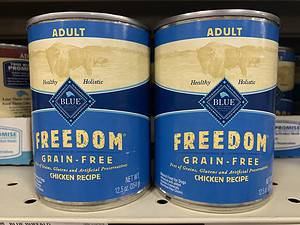Adding fish to our newly set up tank is an exciting experience that many fish keepers look forward to. We take pride in creating an underwater environment that the fish will enjoy. So, it is understandable that we might make the mistake of adding fish to the tank before the appropriate time.
While it might seem like your new tank conditions are suitable for fish, this is not entirely true. A new tank needs to undergo an important process for several weeks to ensure the water is safe for fish. We discuss the details in depth below!
Definitions of Key Concepts
The following definitions are important for new fish keepers to understand and will be used throughout the article.
- Water parameters: The physical, biological, and chemical characteristics of water that determine its quality
- Beneficial bacteria: Nitrifying and heterotrophic bacteria formed during the nitrogen cycle
- Nitrogen cycle: A natural biological process where beneficial bacteria are established to convert waste byproducts (ammonia, nitrite) to a less toxic form (nitrate) safer for fish
- Bioload: The amount of biological/organic waste such as food and poop in an aquarium
How Long Should You Wait Before Putting New Fish in The Tank?
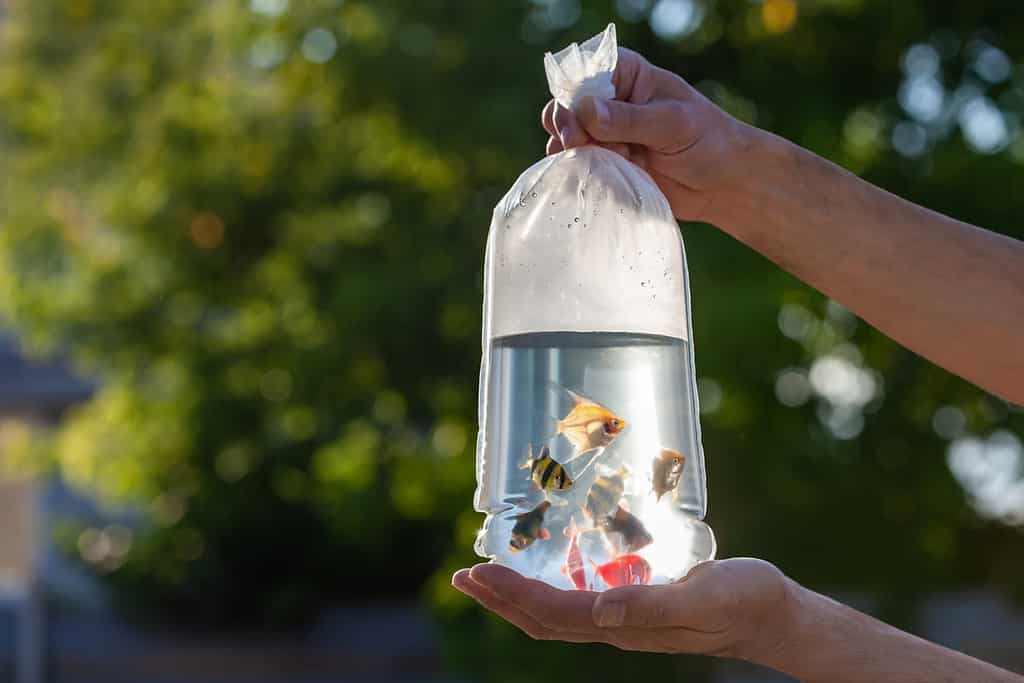
It can take around four to six weeks before the tank is safe for fish.
©Klever_ok/Shutterstock.com
The tank’s filter is running, and the decorations and plants you spent time perfecting look appealing; now, all you need is to add your fish. You might have heard from the pet store that you do not have to wait before adding your new fish in, but experts disagree.
Although the tank looks safe to the naked eye, the water parameters are an unstable mess, which is toxic to even the hardiest fish. The tank first needs to establish beneficial bacteria during a process known as the “nitrogen cycle.” The process can take a while to complete, which is why fish should be introduced into new tanks after a minimum of four to six weeks. However, waiting for the tank to fully cycle before adding in the fish is even better.
Why Do You Need to Wait Before Adding Fish to a New Tank?
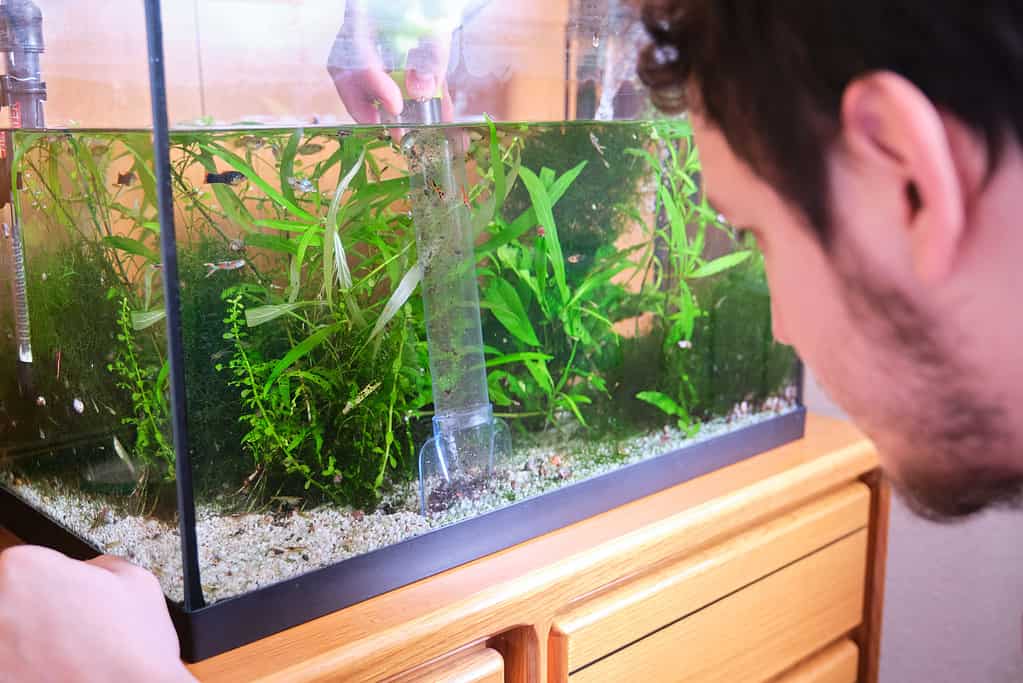
The beneficial bacteria in fish tanks play a vital role in the health and longevity of fish.
©Ladanifer/iStock via Getty Images
- To establish beneficial bacteria
- To prevent fish from dying from ammonia and nitrite toxicity
- To allow the tank to undergo a fishless nitrogen cycling process
While it might be difficult to wait weeks until you can add fish into the new tank, patience is going to be key if you want to keep your fish alive. The four-to-six-week waiting period is often ignored, which can be detrimental to the tank’s inhabitants. This is because the water is unlikely to be safe for fish until beneficial bacteria have established themselves.
The beneficial bacteria convert the waste products like poop and leftover fish food into less toxic forms for the fish. Otherwise, new fish succumb to ammonia and nitrate toxicity, which is often fatal.
Fish are constantly pooping and eating in the water, which contributes to the tank’s bioload. The decomposing organic matter from the fish releases ammonia, which is toxic to fish at the slightest traces. Ammonia toxicity in fish presents as gill and organ damage, visible burns, and eventually death. New tanks usually have ammonia spikes, which can quickly kill fish within a short time. Nitrite is the byproduct of the nitrogen cycle, but it is just as toxic as ammonia.
The beneficial bacteria in an established tank can effectively convert the ammonia and nitrite into nitrates, a less toxic form often safe in aquariums to 20 parts per million (ppm). However, your new fish tank is not yet established, and the water parameters will be out of the ideal range for most fish to survive. This creates an unsuitable environment for both marine and freshwater fish, making the cycling process an essential part of any new tank.
Understanding the Nitrogen Cycle
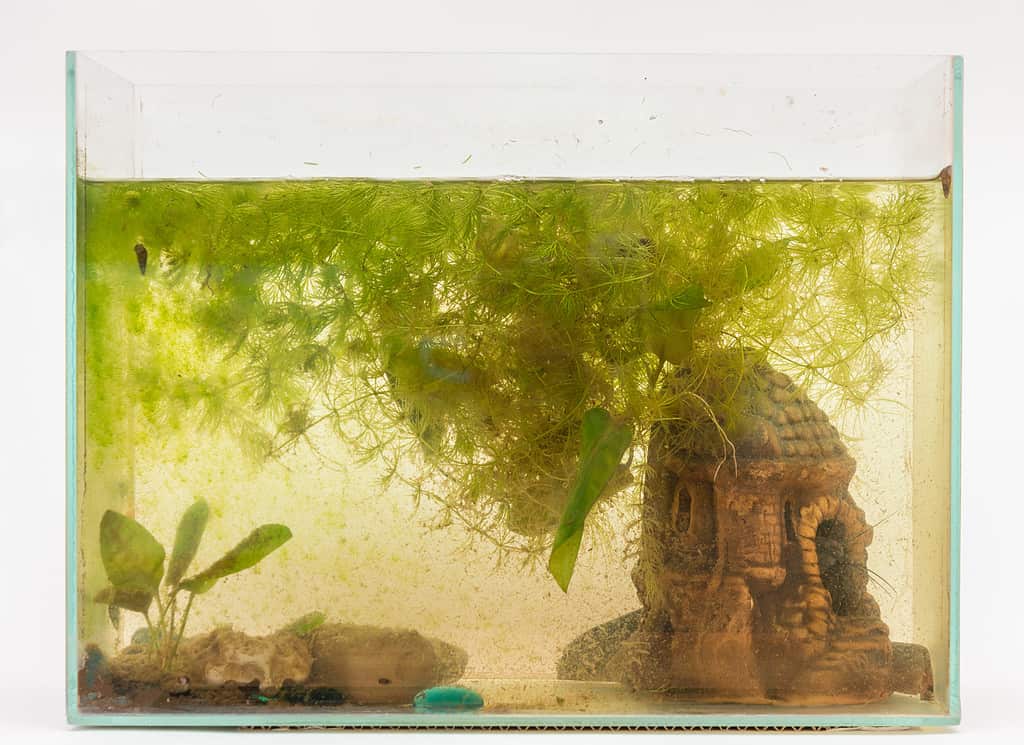
Milky or cloudy aquarium water is caused by a bacterial bloom during the nitrogen cycle.
©Madhourse/iStock via Getty Images
The nitrogen cycle can be long and complicated to explain, but we will simplify it for you. When we say a fish tank is cycling, we refer to one undergoing the nitrogen cycle to establish beneficial bacteria. Various types of beneficial bacteria are formed during the cycle which convert the ammonia from a fish’s organic waste to nitrites and then nitrates. The nitrogen cycle begins once the tank is set up and the filter is running.
Adding a bit of fish food or an ammonia source is needed to kick-start the cycle and give the beneficial bacteria a food source. After several weeks, enough beneficial bacteria will have been established in the filter media, substrate, and surfaces of the tank. Once the fish are ready to be put into the tank, the established beneficial bacteria can break down their waste into less toxic forms. If the cycle didn’t complete itself, the fish waste would build up in the water causing a toxic environment.
There is no guaranteed amount of time to wait until the tank is done cycling. Some tanks take a few weeks to fully cycle, while others can take six months. It is normal for the tank to turn a milky color while cycling, as this is the beneficial bacteria settling. The tank’s water will turn clear soon, and the bacteria should not be disturbed during this time.
6 Critical Tips on Adding Fish into Your Tank
Below are six critical tips to follow before putting fish into your new tank.
1. Let the Tank Cycle for At Least 4 to 6 Weeks
A fish tank needs to cycle for at least four to six weeks before fish are added in. Cycling the tank helps create a safe environment for the fish where their waste can be broken down effectively. It might take longer for some tanks to fully cycle before fish can safely be added. The cycling process depends on the tank size, the type of filtration, and what ammonia sources were used.
2. Keep the Filter Running Even If the Tank is Empty
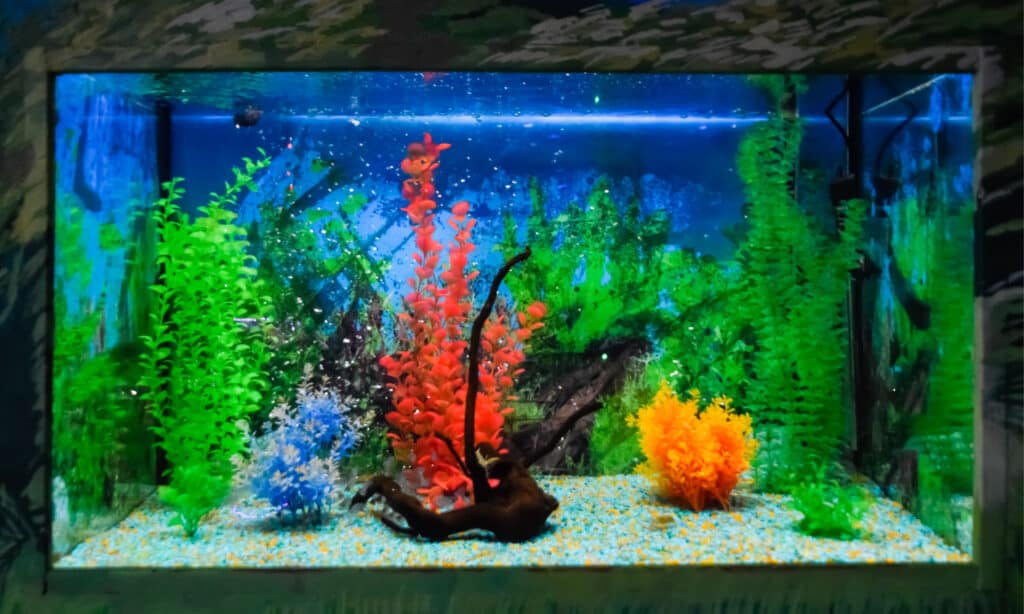
The filter should not be turned off while the tank is cycling.
©iStock.com/Leonid Eremeychuk
Beneficial bacteria during the nitrogen cycle establish on different surfaces in an aquarium, rather than in the water column. The largest colonies of these bacteria are often found in the filter media, whether it be a sponge, activated charcoal, or another porous surface. This makes it essential to keep the filter running 24/7 even if there are no fish in the tank.
The tank’s filter gives the beneficial bacteria water movement and aeration which is necessary for their survival. Furthermore, the filter prevents the water from becoming stagnant and bad bacteria to flourish.
3. Use Water Treatments to Speed Up the Cycling Process
There are various water treatments you can use to speed up your tank’s nitrogen cycle. Aside from needing a water conditioner to remove chlorines and chloramines, you can use concentrated forms of nitrifying bacteria. Popular water treatments containing nitrifying bacteria which are favored by aquarists include Tetra SafeStart, API Quick Start, and Seachem Stability.
4. Regularly Test the Water to Determine Its Safety

A water testing kit can help you determine when the tank is safe for your fish.
©Ladanifer/Shutterstock.com
The measurements of water parameters such as ammonia, nitrite, and nitrate cannot be seen in the water without a liquid testing kit. The liquid testing kit is usually preferred over the testing strips because of its accuracy. Using a liquid testing kit allows you to determine the amount of ammonia, nitrite, or nitrates in the water. The ammonia and nitrite will fluctuate during the cycling process in the new tank.
You can expect the ammonia and nitrite to be around 2 ppm to 3 ppm for the next few weeks. Those are dangerously high levels, which is why many fish die in new tanks. The nitrate levels will only spike once the cycle is completed.
5. Conduct Partial Water Changes Every Few Days
Water changes are a vital part of aquarium water maintenance. The water changes help replenish the tank with fresh water and dilute traces of ammonia, nitrite, and nitrate. Furthermore, the only way to remove large amounts of nitrates in a fish tank is by doing a water change. However, only partial water changes should be done rather than removing all of the tank’s water which can disrupt the tank’s natural balance.
A 10% to 30% water change is recommended a few times a month for new aquariums to dilute the nitrate levels. It is recommended a 50% water change before adding new fish into the tank even if the cycle is completed. The spiked nitrate levels are an indication that the cycle is complete, but it is not safe for fish and should be removed via a water change.
6. Acclimate the Fish Properly
Once you have tested that the water is safe for your fish and the tank has fully cycled, you can begin adding your fish. However, acclimating the fish to the new tank is going to prevent them from becoming stressed. The water chemistry the fish were used to at the pet store or breeder is different from your tank’s water. You must first allow the fish to adjust to the different water temperatures and parameters. This is especially important for the more sensitive fish species.
Fish-In vs. Fishless Cycling
Some fish keepers still choose to add fish into a tank even if it is not cycled yet. They either do it to speed up the process, to save time, or unintentionally. Unfortunately, doing a fish-in-cycle can be tricky, and the fish usually die from the unstable water parameters. Although it might seem like a good idea to skip the cycling process and just add the fish, it should be avoided.
Fish are sensitive to ammonia and nitrite, which causes stress and internal damage that is likely going to kill them. The now dead fish will release high amounts of ammonia which further disrupts other live fish in the tank, leading to more fish deaths. Fish-in-cycles might work for some but generally fail for many. It is better to just use other ammonia sources such as fish food or diluted ammonium chloride.
New Tank Syndrome

Poor water quality in fish tanks is the number one cause of new fish deaths.
©Zay Nyi Nyi/Shutterstock.com
The most common cause of fish deaths in newly set up tanks is “new tank syndrome.” This informal condition occurs when fish are added to an immature tank with unbalanced water parameters. The tank’s water has high levels of ammonia and nitrites which makes the fish incredibly ill. Fish suffering from new tank syndrome will show clear signs of ammonia or nitrite toxicity.
Those signs include:
- Gasping at the water’s surface.
- Flashing behavior.
- Cloudy or smelly water.
- Black burns on gills.
- Lack of appetite.
- Anorexia.
- Eventually death.
Conclusion: When Is It Safe to Put New Fish in a Tank?
The most reliable way to determine whether the new tank is finally safe for your fish is by testing it for chemicals. This allows you to find the exact level of ammonia, nitrite, and nitrates in the water. The ammonia and nitrite levels should be stable at 0 ppm, while the nitrates should be up to 25 ppm.
You can also check the water’s visibility. Milky water is a clear sign of a bacterial bloom and an uncycled tank. Once the water is safe, you can begin the exciting process of adding your fish to the tank!
The photo featured at the top of this post is © Grafner/iStock via Getty Images
Thank you for reading! Have some feedback for us? Contact the AZ Animals editorial team.





